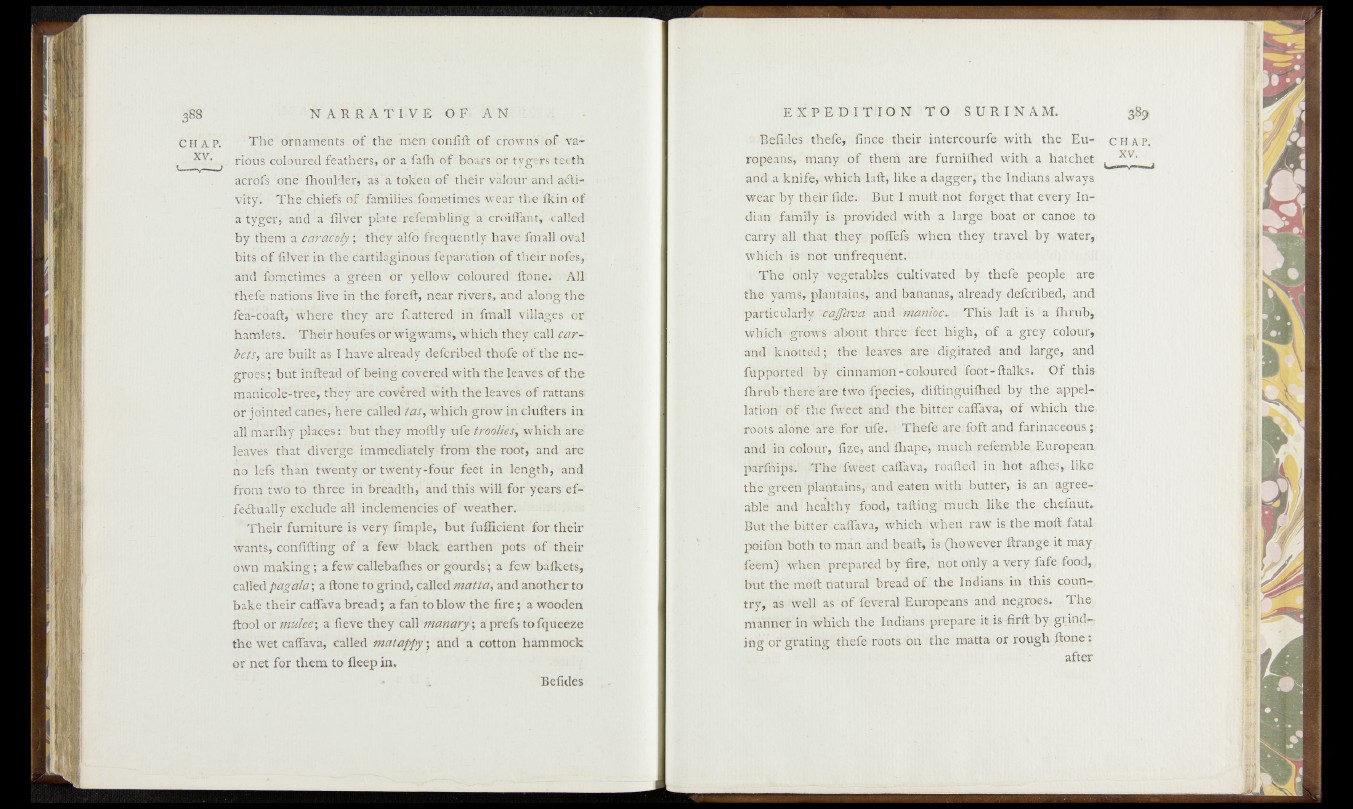
C h A p. ' T h e - ornaments. of the men confift of crowns of va-
- xv> rious coloured feathers, or a falh of boars'or tygers teeth
acrofs one lhoulderj°as' a token of their valour and activity^
’ The chiefs of - families! fomStinhes wear the Ikin of
a tygdf, and a lilver platei feTeEnbliffg^a: cfoiffant, called
by them a e^f^coA ^ they alfo fFeqiaehtly have fmall oval
bits of lilver in the cartilaginous- reparation of their nofes,:
and fometimes- a green or yellow coloured f tone. ; All
thefe natiohs live in the for eft, near rivers, and along the
fea-coaft, where they are fcattered in fmall villageshd^i
hamletsA^ Their houftsbF wigft^am%whieR f t f e ^ a l l ^ r -
te r , are built as I have already defcri-bed thefe of the negroes
; but inftead of being covered- with the leaves' of the
thef-are OTy^red-wfth the leaV'df’of’rattans
or jMifted Cartes jftefft: calledhar, which gfow in clufters in
all marfhy places: | but they moftly ufe tr'oblies, wfek^are
leaves that diverge immediately from the root, and ;afe
no ieftffthan twenty or twenty-four feet in lengthj^anft
twtifo ^Erie in biread thf and-fl^'‘wy|^©r*^i's^fef*-.
fehtually exclude all inclemencies of weatherh
Tfteir furniture is very iimple, bu t Sufficient for< then?
wants, conlifting of a few black earthen pots of their
own Making f a few callebafhes or gourds; a fe w1 bafkets*
called pugala\ a ftone to grind, called matta, and another to
bake their caffava bread; a fan to blow the fire ; a wooden
ftool 6 f fnute&; a fieve they caWmanaryy aprefs tofqueeze
the wet caffava, called matappy y and a cotton hammock
or net for them to lleep in.
Belides
e Belidd$- thefe, finee th e ir‘.intercourfeywith, the Eu- ch ap*
ropeans, rrtiany loï: the hi are Turnifhed with, a hatchet , xv‘
and. a knife,-which laft* hkei-a.ddgg.erjTth e Indian^ always
wear by thèiflfrdë;' -■ ftütftni|M*not fferget that eytery Indian*
family.fsi,provided-«with aftarg&dboat .or canoe, to
carry all that they*} poffefsHwhen: they ...’travel- by watery
which i^'heft -ünfreqüëntie
The -'dhly‘; vegêföbfes ’GuM’vated by^fhefe people are
the5 yams,r,plan'taiftsf-and bananas', --already deferahedi ;,and
particularly and •manmfvi.;Thisvlaft; isda fhrub,
which -grows-1 about t brééd Héét;! high, I of, a grey 1 colour* -
and krtMtëdf the leaves are - digitated» and - large, ,„and
fupportëfff'by cinnamon - coloured' foot- {talks. Of this
Ihrub therè^are two fpeêiesyftiftihguilhed by the appel-J .
Ikticlri:’d f ;fh^ fwteét And'the bitteft caffava, .of which’yhe»
tuotf-alèWeSare!’for• Rfë:- $ -Théfë*arei%Ctland farinaee%U§ik'
and in ödtour, fige,^a'hd;f f ii^ lf tip c h refemble.jEUrppean.
ftafftiipst* -The Tweet-caiava, réafted'. In* hot alhp§y like
tbe^greèn"piarvt-ains/*an d eaten with.Jjutier, is „an fagree^f
able and ’ healthjr food, tafting'mubhftike thevchefnut.
Buf th e bittdn.ckffava, w hi clu I when t r a W is£he molt fatal-
poifon Eoth to<man and beaft, fi's^however ftrange it may •
fe'l m )' ^vhfefi I prepared b y ftre / not o n jy ^ ^ r.y fafe.-food,,
but. the möft natural bread of 1 the ïndianlsjin tthis cqqn-.
try, as well as of feVerft Europeans and negroes*- Thej
manftéf in ^SlÉifilsè Indians .prepare i t gïl^JÏIï
ing or grating thefe roots ón uhe.naafta--or rough ftone 1
after